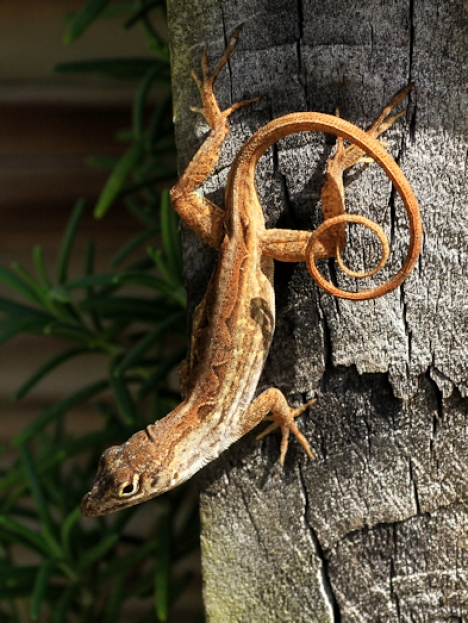In a (somewhat) recent blog post entitled “Is there a crisis in Anolis taxonomy?”, Julian Velasco invited discussion on a perceived decline in the number of new anole taxonomists. While it was a fun look at the dynamics of anole taxonomy over time, I couldn’t help but feel like there is a more pressing taxonomic crisis going on right now, and it affects many of the researchers that frequent this blog.
I fear too many species of Anolis are being described based on questionable evidence. While this problem is not unique to anoles (a common term for it is “taxonomic inflation”; Isaac et al. 2004), a number of recently described anole species may be the result of overzealous taxonomic splitting. I will give some examples below and then briefly discuss two lines of evidence that I believe are often used to divide species inappropriately. Before I do so, it’s worth stating up front that I’ll focus on the work of Dr. Gunther Köhler and colleagues. This shouldn’t be surprising, as Dr. Köhler is the most prolific living describer of anole species. The following criticisms should not be seen as personal, as Köhler is not unique on any of the points I discuss below. But with many cryptic species described or resurrected over the past 10-15 years, his work has the largest impact on anole taxonomy and the science that depends on it.
I’ll start with the revision of the Anolis tropidonotus complex published in Mesoamerican Herpetology (Köhler et al. 2016). Below I provide a quick breakdown of the paper. I hope that others will contribute their own views on this work in the comments. The A. tropidonotus group is one that I am well-acquainted with, having spent months of field time collecting individuals across the distribution of the group. Köhler et al. (2016) raise a subspecies (A. tropidonotus spilorhipis) to species status while describing two new species, A. wilsoni and A. mccraniei. Unfortunately, the data presented–morphology and DNA–do not appear to strongly support the recognition of any new species level taxa. I argue that the inference of four species within A. tropidonotus sensu lato should require stronger evidence than that presented.
The authors sequenced 16S mitochondrial DNA for molecular analyses and present a consensus tree from Bayesian analyses of these data. This tree recovers four well-supported and geographically circumscribed mtDNA haplotype clades that correspond with the four new species. A table following the tree reveals the genetic distances between putatively new species topped out at 4.5%. This level of mitochondrial divergence is significantly less than intraspecific variation observed in other anoles (Malhotra & Thorpe 2000; Thorpe & Stenson 2003; Ng & Glor 2011). Moreover, Köhler et al.’s (2016) sampling map reflects sparse sampling of molecular data.
Based on Figure 3, morphology (other than perhaps hemipenes, which I discuss below) does not provide any support for delimitation of those populations characterized by distinct mtDNA haplotypes. The dewlap differences reported are slight and appear to fall within the type of variation observed within and among other populations of species in this group (see photos at the top of this post for an example of two spilorhipis males that came from the same locality; photos courtesy Luke Mahler). Bottom line–we see several populations with mitochondrial haplotypes that cluster together geographically with little to no morphological evidence for divergence.
The phylogenetic and morphological patterns displayed in Köhler et al. (2016) are consistent with patchy sampling of a widespread and continuously distributed species with potentially locally-adapted populations. The authors cite “the high degree of genetic distinctiveness… as evidence for a lack of gene flow, and conclude that these four lineages represent species-level units” (Köhler et al. 2016). This assumption is questionable, as researchers have long known of the pitfalls of using mtDNA to determine gene flow (Avise et al. 1983; Avise et al. 1984; Funk & Omland 2003) and supporting evidence from morphology is lacking. The different hemipenial types represent the strongest evidence for recognizing the lineages mtDNA haplotype groups. Below I will discuss the utility of those traits for species delimitation.
Finally, the authors did not compare their purported new tropidonotus-like species to Anolis wampuensis, a morphologically indistinguishable (McCranie & Kohler 2015) form that is potentially codistributed with the new species A. mccraniei. This should have been done to avoid the possibility that A. wampuensis is conspecific with one of the newly named forms.
Another example of taxonomic inflation in Anolis is from a 2014 monograph in Zootaxa (Köhler et al. 2014).
























 We do know why they raise their dorsal crests–to look fearsome, as this mini-dinosaur does. How they do it, though, is another matter, when discussed previously in these pages (
We do know why they raise their dorsal crests–to look fearsome, as this mini-dinosaur does. How they do it, though, is another matter, when discussed previously in these pages (